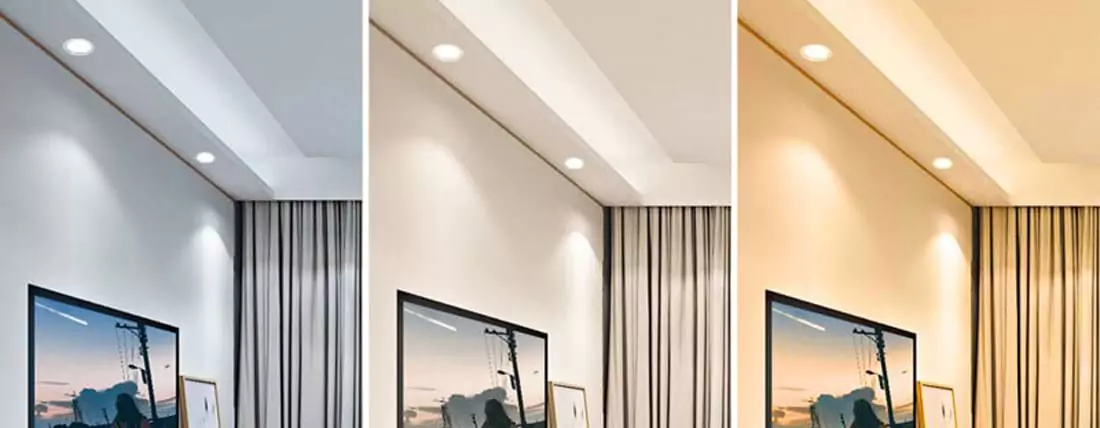Introduction
Quality sleep is important for a healthy life, and the type of led light color you use can make a big difference. In this guide, we’ll talk about how the colors of LED lights affect your sleep. First, we’ll explain how natural light controls your sleep patterns. Then, we’ll focus on the effects of blue light, which can disrupt your sleep.
But the main part of our discussion is about warm white LED lights, which are known for helping you sleep. These lights have a lower color temperature and create a calming atmosphere like evening sunlight, signaling to your body that it’s time to relax and get ready for sleep.
We’ll explain the science behind this calming light and give you tips on choosing the right LED bulbs, including dimmable and smart options, to create a sleep-friendly environment. By the end of this guide, you’ll have the knowledge to make a simple but important change that can greatly improve your sleep.
Understanding Circadian Rhythms
The key to understanding your sleep patterns is the idea of circadian rhythms, which are like your body’s internal clock. These rhythms decide when you feel most awake and when you naturally get sleepy.

Our internal clocks are greatly affected by light. When the sun is out, our bodies receive a signal to be awake and active. On the other hand, when it’s dark, especially in the evening, our bodies take this as a sign to relax and get ready for a good night’s sleep.
Natural light, especially sunlight, is important for keeping our internal body clock in sync. It helps regulate our circadian rhythms, which are responsible for our sleep-wake cycle. When we are exposed to daylight in the morning, it boosts our alertness and keeps our internal clock on track. That’s why a sunny morning can make us feel more awake and energized.
When the day turns into night and it gets dark, our bodies start getting ready for sleep. This gradual change from light to darkness is a gentle reminder from our internal body clocks to relax and prepare for a good night’s sleep.
In other words, circadian rhythms are what cause our energy levels to naturally rise and fall throughout the day. They also explain why being exposed to the right kind of light color at the right time can greatly affect the quality of your sleep.
The Role of Blue Light
1. Introducing Blue Light: Blue light is everywhere, especially in daylight, and it’s also emitted by the screens of our favorite electronic devices. It’s like the new addition to the world of light.
2. A Part of Our Lives: In our modern lives, filled with screens, we are always surrounded by blue light. Our smartphones, tablets, and computers all emit it, and even some energy-efficient LED bulbs have a bluish tinge. Blue light is now a big part of our daily routines.

3. Evening Exposure: While blue light isn’t necessarily harmful, it’s the timing of when we’re exposed to it that matters. In the evening, especially before bedtime, exposure to blue light can disrupt our sleep preparation. This is because our body’s natural sleep-wake cycle, known as the circadian rhythm, is getting ready for sleep, but the blue light sends a conflicting signal.
4. Decreased Melatonin Production: Blue light presents a challenge by reducing the production of melatonin, which is the hormone that helps us fall asleep. Melatonin acts like the Sandman, making us feel sleepy and keeping us asleep throughout the night. However, when blue light disrupts melatonin production, it can become more difficult to fall asleep and staying asleep can be a challenge.
So, while blue light is helpful during the day to keep us awake and energetic, it’s important to be aware of its impact, especially in the evening when you’re preparing for a good night’s sleep.
The Benefits of Warm White Light Color
Understanding warm white light is interesting. Exposure to this color temperature promotes the production of melatonin. Melatonin is often called the “sleep hormone” and helps regulate sleep patterns, promoting deep and restful sleep. Therefore, warm white LED light color create a sleep-friendly environment.
1. Soft Lighting: When it comes to creating a sleep-friendly environment, soft lighting takes center stage. This type of lighting is like a gentle lullaby for your senses, soothing you into a restful slumber.
2. Importance of Color Temperature: The key to their appeal is their color temperature, measured in Kelvins (K), which usually falls between 2700-3000K. This lower color temperature produces a cozy, welcoming glow similar to the gentle hues of sunset.
3. Evening Sunshine at Home: Warm white LED lights create a cozy sunset-like atmosphere in your living space. This gentle and soothing ambiance tells your body it’s time to relax and prepare for a restful night’s sleep.

4. Other Light Options: In addition to warm white, there are other lighting options you may want to think about for various times of the day:
- Warm Colors (e.g., Yellow or Orange): These warm colors are known to help you relax and feel less excited. They imitate the light you see during sunset, which helps your body get ready for sleep.
- Daylight or Natural White: With a higher color temperature similar to daytime sunlight, this type of lighting enhances alertness and focus when used in the morning or during the day. However, using it at night can potentially disrupt your sleep.
So, when you’re picking lights for your bedroom, keep in mind that warm white LED lights are perfect for creating a calm sleep environment. Their soft glow, resembling the beauty of sunset, will help you have a peaceful night’s sleep.
Choosing the Right LED Light color
Choosing the right LED light colors for your bedroom is important. Go for LED light with warm white color temperatures, usually between 2700-3000K. You can use these bulbs in different fixtures, like bedside lamps, pendant lights, or ceiling fixtures, to create a cozy and welcoming atmosphere.
For a customizable and adjustable lighting experience that promotes better sleep, consider using dimmable LED lights. These bulb lights give you the ability to control the brightness based on your mood and sleep preferences. Alternatively, you can explore smart lighting systems that can be programmed to gradually dim the lights as bedtime approaches.
In addition to LED light color, how bright or intense the light is also matters. Finding the right balance is important; you don’t want it to be too bright, but you also don’t want it to be too dim. Using fixtures like bedside lamps or wall sconces can help create a sleep-friendly environment.
Lighting in the Evening Routine
When it comes to your evening routine, the choice of LED light color can play a significant role in setting the right mood and preparing your body for a restful night’s sleep. Opting for warm white lighting can have a calming effect on your mind and body, creating a serene environment that promotes relaxation and tranquility.
As you wind down for the night, the soft glow of warm white LED lights mimics the gentle hues of sunset, signaling to your body that it’s time to unwind and prepare for sleep. This soothing ambiance can enhance your evening activities, such as reading a book or engaging in relaxation exercises, creating a peaceful and enjoyable experience.

Research suggests that exposure to warm white light, with its lower color temperature falling between 2700-3000K, can promote the production of melatonin, often referred to as the “sleep hormone.” Melatonin helps regulate your sleep patterns, ensuring deep and restful sleep. By incorporating warm white LED lights into your evening routine, you can create a sleep-friendly environment that supports a healthy sleep-wake cycle.
Furthermore, the choice of lighting color can have a direct impact on your circadian rhythm, which governs your body’s natural sleep-wake cycle. When exposed to blue light, commonly emitted by electronic devices and energy-efficient LED bulbs, your circadian rhythm can be disrupted, making it harder to fall asleep and stay asleep throughout the night. By opting for warm white LED lights instead, you can minimize the negative effects of blue light and encourage a smoother transition to a peaceful night’s sleep.
So, when it’s time to prepare for bed, consider the use of warm white LED lighting in your evening routine. Whether you’re unwinding with a good book or practicing relaxation techniques, the soft glow of warm white light can create a soothing atmosphere that helps you relax and signals to your body that it’s time to sleep. By making this small but significant change, you can optimize your sleep environment and pave the way for a restorative night of sleep.
Conclusion
In the pursuit of better sleep, the choice of LED light color is crucial. Warm white LED lights have properties that promote sleep and offer a simple yet effective way to enhance sleep quality. By considering factors like color temperature, dimming options, and suitable fixtures, you can create a sleep-friendly lighting environment in your bedroom.
To summarize, switching to warm white LED lights is a small change that can bring about significant improvements in your sleep. So, why wait? Enhance your sleep by using warm white LED lighting in your bedroom. It creates a calming and refreshing atmosphere, helping you have sweet dreams.
Author
-

I'm Joseph, the Co-founder of CST Lighting, bringing over a decade of expertise in the LED lighting industry. With a strong focus on product marketing, I am dedicated to staying at the forefront of market trends, constantly enhancing my knowledge and skills to deliver top-notch products and services to our clients. Through our insightful blog posts, we strive to share our expertise, guiding readers through the ever-evolving landscape of LED lighting. Learn more via my linkedin profile https://www.linkedin.com/in/ledcst-joseph/
View all posts


